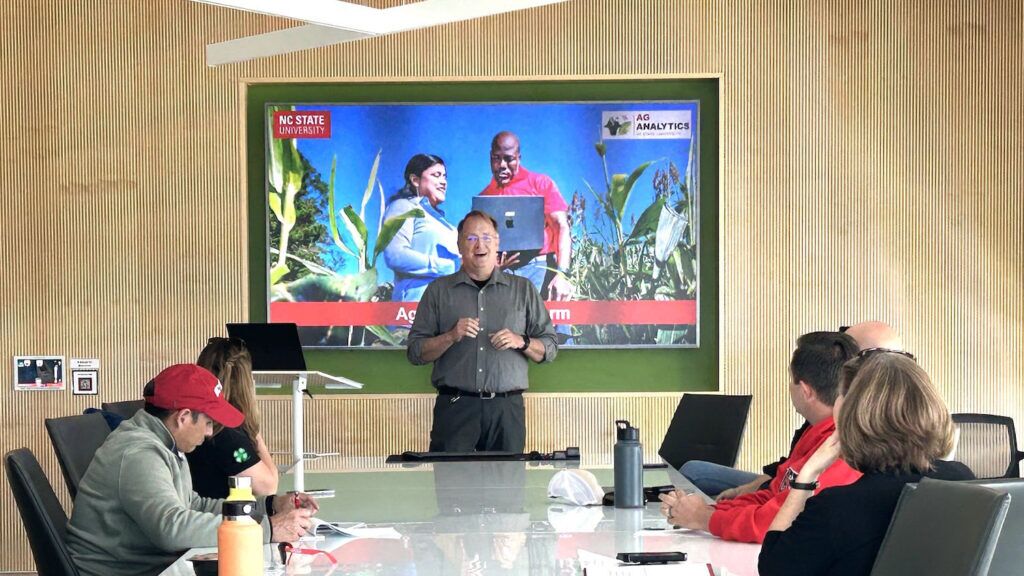Oregon Farm to School Network launches 10-year vision plan – Oregon State University

Oregon’s Farm to School Strategic Vision: A Framework for Advancing Sustainable Development Goals
Introduction and Strategic Alignment with SDGs
The state of Oregon has launched a new strategic plan, Oregon Harvest for Schools: 10-Year Strategic Vision for Oregon Farm to School (2025–2035). This roadmap, developed by the Oregon Farm to School Network and its partners, including the Oregon State University (OSU) Extension Service, aims to build a healthier and more resilient future. The vision directly supports several United Nations Sustainable Development Goals (SDGs) by seeking to improve child health and well-being (SDG 3), support academic achievement (SDG 4), promote environmental resilience (SDG 11, SDG 12), and invigorate the local agricultural economy (SDG 8).
Collaborative Framework and Partnership (SDG 17)
The strategic vision exemplifies SDG 17 (Partnerships for the Goals) through its highly collaborative development process. The initiative represents a coordinated effort to align resources across public and private sectors for durable, lasting impact. Key partners in this statewide effort include:
- Oregon Farm to School Network
- OSU Extension Service
- Oregon Department of Education
- Oregon Department of Agriculture
- FoodCorps
- Ecotrust
- Oregon Dairy Council
- Raindrop Workshop
The plan’s development was a grassroots process, with nearly 850 Oregonians reviewing the draft and providing extensive feedback, ensuring the vision is inclusive and impactful.
Key Achievements and Program Impact
Oregon has established a strong foundation as a national leader in the farm-to-school movement since 2007. The program’s success demonstrates tangible progress toward key SDGs. Notable achievements include:
- Over $40 million invested by the Oregon Legislature in farm-to-school grants, contributing to economic growth (SDG 8).
- 85% of Oregon’s Child Nutrition Programs now purchase local foods, promoting responsible consumption (SDG 12) and supporting local producers (SDG 2).
- Nearly 800 school garden sites have been identified statewide, providing educational opportunities (SDG 4) and promoting good health (SDG 3).
The 2035 Vision: Five Interconnected Goals for Sustainable Development
The 10-year vision identifies five interconnected goals to guide progress through 2035, each aligning with specific SDGs:
- Food Education for All: This goal aims to provide all Oregon students with hands-on food, agriculture, and garden-based learning. This directly supports SDG 4 (Quality Education) by enhancing learning environments and promotes SDG 3 (Good Health and Well-being) through nutrition education.
- Local Food Access for All: By ensuring every student has access to locally grown, caught, or processed foods, this goal targets SDG 2 (Zero Hunger). It also strengthens local food systems, contributing to SDG 12 (Responsible Consumption and Production).
- School Food Culture and Environment: Creating meal environments that reflect cultural traditions and elevate student voice contributes to inclusive and sustainable communities (SDG 11) and fosters lifelong healthy habits (SDG 3).
- Leadership and Professional Development: This goal focuses on creating career pathways for educators and nutrition professionals, aligning with SDG 8 (Decent Work and Economic Growth) by supporting a skilled workforce.
- Market Access and Development for Oregon Producers: By building regional supply chains and providing training, this objective directly advances SDG 8 (Decent Work and Economic Growth) and supports sustainable agriculture (SDG 2) by creating inclusive pathways into farm-to-school markets.
Stakeholder Endorsements and Future Outlook
Leaders from the Oregon Department of Education, Oregon Department of Agriculture, and FoodCorps have endorsed the vision, highlighting its role in achieving shared commitments. Charlene Williams, Director of the Oregon Department of Education, noted that “healthy students are better learners,” linking the program to both well-being (SDG 3) and academic success (SDG 4). Lisa Charpilloz Hanson, Director of the Oregon Department of Agriculture, emphasized the program’s role in building a resilient food system that serves all Oregonians, a key component of SDG 2 and SDG 11. The strategic vision solidifies Oregon’s commitment to using farm-to-school programs as a proven model for achieving equitable and sustainable development across the state.
SDGs Addressed in the Article
Relevant Sustainable Development Goals
- SDG 2: Zero Hunger: The article directly addresses this goal by focusing on ensuring children have access to nutritious food and supporting local agriculture. The Oregon Farm to School Network’s vision is to “ensure every child has access to delicious, nutritious local food” and to “invigorate the agricultural economy,” which aligns with ending hunger, achieving food security, and promoting sustainable agriculture.
- SDG 3: Good Health and Well-being: The program’s aim to “equitably improve child health and well-being” and the statement that “Healthy students are better learners” connect directly to this goal. By providing nutritious, local food and education on nutrition, the initiative promotes healthy lives for children.
- SDG 4: Quality Education: The article highlights a strong educational component. The goal of “Food Education for All” aims to provide “hands-on food, agriculture and garden-based learning in classrooms.” This initiative supports academic achievement and provides students with knowledge about food systems, nutrition, and agriculture.
- SDG 8: Decent Work and Economic Growth: The program is designed to “invigorate the agricultural economy” and “strengthen Oregon’s economy.” By creating “Market Access and Development for Oregon Producers,” it supports local farmers and food makers, contributing to local economic growth.
- SDG 11: Sustainable Cities and Communities: The focus on creating “reliable regional food supply chains” and building a “resilient food system” contributes to making communities more sustainable and resilient. The program strengthens the connection between urban/school communities and rural agricultural producers.
- SDG 12: Responsible Consumption and Production: By connecting schools directly with local producers and educating children “about where their food comes from,” the program promotes sustainable and local consumption patterns. The high rate of local food purchasing (“85% of Oregon’s Child Nutrition Programs now purchase local foods”) is a clear example of responsible consumption.
- SDG 17: Partnerships for the Goals: The article emphasizes that the strategic vision is one of Oregon’s “most collaborative statewide efforts to date.” It details partnerships between OSU Extension, state departments (Education, Agriculture), nonprofits (FoodCorps, Ecotrust), and private entities, showcasing a multi-stakeholder approach to achieving the goals.
Specific SDG Targets Identified
Identified Targets
- Target 2.1: End hunger and ensure access by all people to safe, nutritious and sufficient food. The program’s goal of “Local Food Access for All,” which ensures “Every student in Oregon’s Child Nutrition Programs has access to locally grown, caught or processed foods,” directly supports this target.
- Target 2.3: Double the agricultural productivity and incomes of small-scale food producers. The strategic goal of “Market Access and Development for Oregon Producers” aims to create “inclusive pathways into farm to school markets,” which helps support and increase the income of local food producers.
- Target 4.7: Ensure that all learners acquire the knowledge and skills needed to promote sustainable development. The goal of “Food Education for All” provides students with “hands-on food, agriculture and garden-based learning,” which directly contributes to education for sustainable development and lifestyles.
- Target 12.8: Ensure that people everywhere have the relevant information and awareness for sustainable development. The program’s educational activities, which “connect children… with food grown in their communities and nurture lifelong curiosity about agriculture and nutrition,” align with this target by raising awareness among the next generation.
- Target 17.17: Encourage and promote effective public, public-private and civil society partnerships. The article is a case study for this target, describing how the “Oregon Farm to School Network, OSU Extension, Oregon Department of Education, Oregon Department of Agriculture, FoodCorps, Ecotrust, Oregon Dairy Council and Raindrop Workshop worked together” to create the strategic plan.
Indicators for Measuring Progress
Mentioned or Implied Indicators
- Percentage of schools purchasing local food: The article provides a direct metric for local procurement, stating that “85% of Oregon’s Child Nutrition Programs now purchase local foods.” This can be used to track progress towards targets related to local food access and sustainable consumption.
- Number of school gardens: The article quantifies the reach of its educational initiatives by stating there are “Nearly 800 school garden sites identified statewide, with 463 active programs.” This serves as an indicator for progress in hands-on food and agriculture education.
- Financial investment in programs: The level of commitment is measured by financial data. The article notes, “More than $40 million invested by the Oregon Legislature in farm to school grants, including $11.3 million in the 2025–27… budgets.” This indicates the scale of public support and investment.
- Number of stakeholders involved: The article implies the breadth of its partnership by listing the number of participants: “nearly 1,000 educators, 500 food producers, 400 nonprofits and nearly 300 child nutrition professionals.” This data can be used as an indicator for the strength and reach of the collaborative network.
Summary Table of SDGs, Targets, and Indicators
Analysis Summary
| SDGs | Targets | Indicators |
|---|---|---|
| SDG 2: Zero Hunger | 2.1: Ensure access to safe, nutritious and sufficient food. | Percentage of Child Nutrition Programs purchasing local foods (currently 85%). |
| SDG 4: Quality Education | 4.7: Ensure all learners acquire knowledge and skills for sustainable development. | Number of active school garden programs (currently 463). |
| SDG 8: Decent Work and Economic Growth | 2.3: Increase incomes of small-scale food producers. | Number of food producers participating in the network (currently 500). |
| SDG 12: Responsible Consumption and Production | 12.8: Ensure people have relevant information for sustainable lifestyles. | Number of students reached through food, agriculture, and garden-based learning. |
| SDG 17: Partnerships for the Goals | 17.17: Encourage effective public, public-private and civil society partnerships. | Total financial investment from public and private sources (over $40 million from the legislature). Number of diverse partners involved (educators, producers, nonprofits, etc.). |
Source: news.oregonstate.edu
What is Your Reaction?
 Like
0
Like
0
 Dislike
0
Dislike
0
 Love
0
Love
0
 Funny
0
Funny
0
 Angry
0
Angry
0
 Sad
0
Sad
0
 Wow
0
Wow
0














































/environment-climate-change-and-health-(ech)/water-sanitation-hygiene-and-health-(wsh)/landfill-tuvalu-36092.tmb-1200v.jpg?sfvrsn=5c21fe40_1#)



.jpg.webp?itok=0ZsAnae9#)
























